
Location: La Perouse, NSW
Established: 1928
Architect: Dr. Alister MacKenzie (1928)/ Eric Apperly (1937 & 1951)/ Norman & Harrison (2010)/ Greg Norman (2018)/ Tom Doak (2019)
First Played: 13th Feb 2011
Last Played: 29th June 2018
Magazine Ratings

6 (Current)

9 (Current)
I finally managed to take up an offer to play NSW GC, by one of its members, John, who I had met at The Lakes G.C. five months before. I can say the wait was well worth while.
NSW Golf Club is located in La Perouse, on the northern head of Botany Bay. This site overlooks the landing spot of Captain Cook in 1770 on the southern headland.

Entrance to NSW Golf Club
After WWI, the Commonwealth government decided to lease the windswept barren land to the NSW GC for development of a golf links. Dr Alister MacKenzie was invited to view the site in 1926, after the initial 27 hole layout in the original prospectus was not looked upon favourably. In 1927 construction started on MacKenzies design, seeing the course officially opened in 1928, even though not fully complete. Over the years the course has undergone various changes, including some significant changes made by Eric Apperly (who also completed MacKenzies original bunkering plan), but also due to the army taking the land back during WWII.

Course map of NSW Golf Course

Scorecard for NSW Golf Club
Having watched the course being played during the 2009 Australian Open, I was full of great expectation when we started the round, having memorised a lot of the holes from the TV coverage.
Note there are photos taken from two different trips, so those appearing with more brown colouring in the grass were taken during a winter trip.

View from the 1st tee on this short par 4
You start with the easiest hole on the golf course, a 278 meter par 4. Playing safely over vegetation to a gully, the ball will tend to roll to the right. Trouble on the left is to be avoided. There are also no water hazards on most of the course, so potential for lost balls exist everywhere.

Looking back from the 1st green
The green is all up hill from the fairway with a pot bunker on the right. Significant slopes on the green couple with those surrounding the green ensure any shots not accurate might not find the putting surface.

Hole 2 – 165 meter par 3 – The large swale from the middle of the green can take the best of tee shots
After starting with the easiest hole on the course as the first, you then come upon the hardest par 3 on the layout. At 165 meters, this par 3 is played slightly downhill to a green which has been built on top of a mound. A small stretch of bush separates the tee from the hole, the green has two pot bunkers to the left

The second green has a large swale in the middle left hand side
The biggest issue on this hole however is the green, being a small target. The swale running from the middle of the green to the left is quite large and is sure to see many shots which hit the green actually finish well off the putting surface.

3rd Hole – 342 meter par 4 (taken from the 8th green)
The next hole, a 342 meter par 4, doglegs to the left. You have a blind tee shot up a hill to try and reach the fairway. If you were playing without any assistance this would be a tough hole. I got the tip to aim between the tallest trees on the left, which should cut a bit of distance of the hole. Unfortunately I managed to run right through the fairway, leaving a difficult approach to the green. This was located at the top of a steep incline (at the time it almost looked like Everest).

Looking back from the 3rd green
Four traps protect the very undulating green, one more of a fairway bunker on the right, with two pots sitting either side at the front and one back right. The green also slopes away in all direction, especially at the front, so it is imperative to hit the middle. Walk away with par here and you can be happy.

Hole 5 – 445 meter par 5 – a large hill is to be carried from the tee
The next two holes are spectacular as the ocean views start coming into play. Hole 5, a 445 meter par 5, starts with a tee shot playing down to a deep valley, for most mere mortals. With aspirations of playing like the pros, carrying the valley and reaching the next peak, which would see the ball run down the hill towards the green, it was not meant to be. The wind had picked up slightly so this became an enormous task. So you are faced with a blind fairway shot over a large hill. If you hit to the middle of the fairway the ball will run down the other side towards the green, allowing hopefully for a more manageable approach to the green. Anything to either side and the rough will stop the ball in its tracks.

Downhill shot to the 5th green
Once you have navigated to the down slope you are left with a beautiful view of the Tasman Sea. Four pot bunkers protect the green, two short of the green on the left, the other two at the greens edge on either side. The putting surface slopes from back to front and slightly right to left. A relatively easy green, but ensure you spend some moments to take in the view.
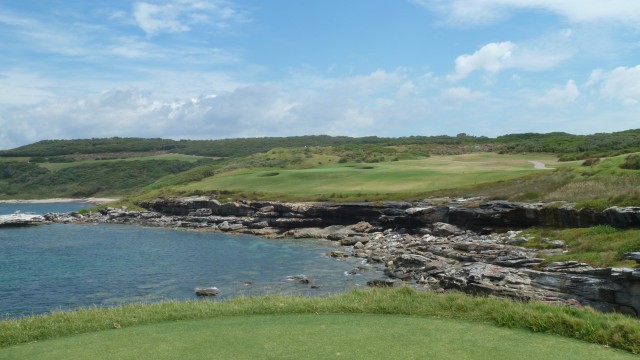
6th Hole – 154 meter par 3
The sixth, a 154 meter par 3, is the most stunning on the course. From the championship tees (177 meters) the hole plays with a carry over the oceans edge. Playing from the members tees, the carry was not as severe, but no less spectacular. Pot bunkers protect the green left and right, with a huge swale front left ensuring anything short does not run on the green.

Playing partner Billy – 6th bunker
The putting surface runs from right to left, so any bunker or chip shots from the right side need to be played with care, to ensure you don’t run through the green. I would rate this hole up there with Narooma’s third hole.

Looking back over the 6th hole from the 7th tee
From here you can see two sets of tees for the 6th. The main competition tees out on the rocks, which a bridge must be crossed to reach, then the normal tees used most days on the main land.

Hole 7 – 365 meter uphill par 4
Hole 7, a 365 meter par 4 hole, is the second hardest on the course. Playing all uphill, this hole plays much longer than the stated yardage. Being relatively straight with an expansive fairway, sloping inwards from both sides, the only real danger off the tee is a total mishit ball. Distance is a premium here though, anything not finding the fairway will be stopped by the rough.
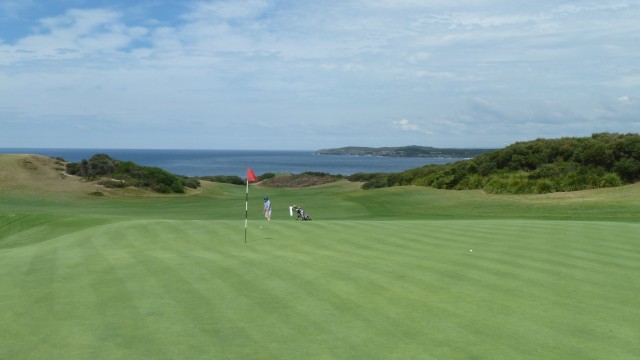
7th green – Looking back toward the tee has great water views
The green is protected by a bunker at the front right, but also a large false front. Sloping from back to front, there a are many undulation to the green. Ensuring you hit the correct portion of the green is critical. Anything long will leave a tough putt or chip to the hole.

Hole 8 – 495 meter par 5
The longest part 5 on the course and also the hardest. From the tee you play to a hill, which is a struggle to carry on any given day. This leaves a blind shot to reach the other side and allow hopefully an easy shot to the green.
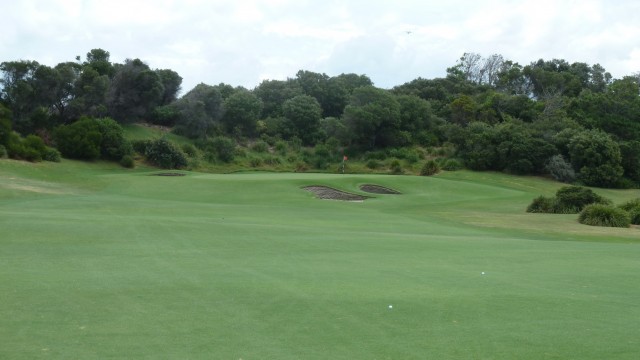
Approach to the 8th green
If you have managed to find the fairway over the hill it is best to be on the left side, taking the bunkers slightly out of play which protect the elevated green. Some of these are nasty little pots, which may see you playing out to the side or backwards.

Hole 9 – 334 meter par 4
From the tee this hole plays with a gentle turn to the left. The fairway slopes right to left so ensure you play to the right, but not too far due to the scrub which will be glad to hide your ball.
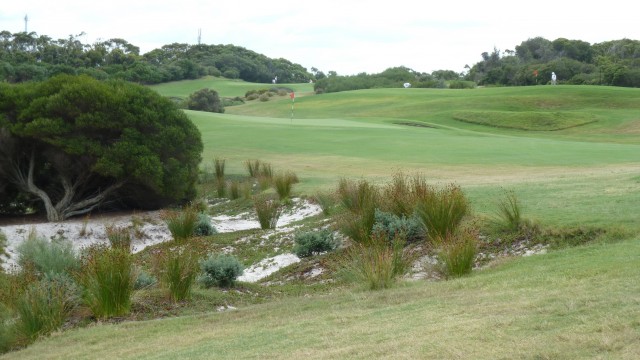
Approach to the 9th green
Sandy waste is found on the left of the fairway which will leave a tricky shot to the green. The green slopes drastically away on the left side and also long. Even though a short hole, par can be difficult.

Hole 10 – 333 meter par 4
The tenth was the first hole played on the day, due to competition play, but was an impressive site as my first hole on the course. This 333 meter par 4 is a straight hole, but has a large bank running along the left of the fairway. There is also a bunker located on this bank followed by waste area. Any ball played too far to the left will reach the 9th fairway, but still leaves a chance of reaching the green.
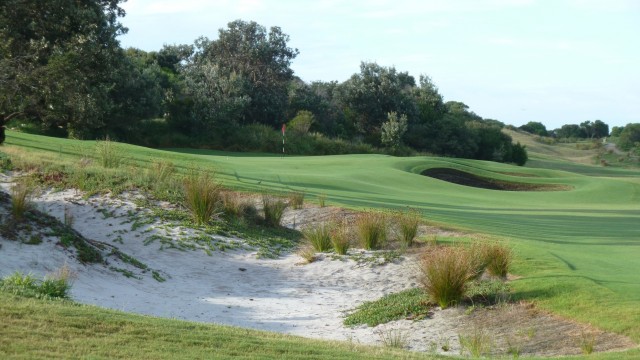
Approach to the 10th green – waste and plenty of bunkers protect the green
From the 10th fairway, the green is raised, with 3 pot bunkers along the right and one to the left. Anything long will find scrub and an unplayable ball. Slight undulations are found on this green which is narrow but long.

Hole 11 – 145 meter par 3
The 11th hole is a short par 3, but has plenty of trouble for any mishit. Vegetation is found from tee to just short of the green.

Slopes and bunkers protect the 11th green
A large false front is also present which will see any balls not hit long enough, rolling away back down the hill. There are some step slopes on this green which also make it a little tricky.

Hole 12 – 464 meter par 5
From the elevated tee there is plenty of landing space for your drive. Sandy waste is found on the left as you approach the first mound, which can be carried giving a little extra distance.

Large pot bunkers surround the 12th green
Making your way along the fairway there is a small gully, filled with rough which nears the approach to the green and could be in play with your second shot. The green is not overly wide but quite long. Pot bunkers can be found either side of the green.

13th – 370 meter par 4
Hole 13 takes us back along the shore line of Botany Bay. This 370 meter par 4, has a slight dogleg to the left and plays mostly downhill. Pressure builds from the tee, with a shot through a narrow chute of tea tree, before reaching the fairway. There is a bit of room to bail out to the right, but leave a long approach to the green, although going to far will leave the ball unplayable.

Approach to the 13th green
Turning at the dogleg you are left with a scenic view of an elevated green and the south heads of Botany Bay. Protected by two pot bunkers to the left and one to the right, this green has a false front to repel any ball. The green mostly slopes back to front. Landing long will leave a tricky putt.

Hole 14 – a 303 meter par 4
Playing over a ravine to the fairway which is covered in vegetation is not the only danger on this hole. Although short the ball will roll to the left due to the fairway sloping. If long enough you will land safely in a valley left with an uphill shot to the green. It is possible to run through the fairway and loose your ball (I can attest to this).

The raised 14th green
This green is no easy feat to hit. Playing up the hill you have an elevated green with two distinct tiers. The green is not overly deep so easy to play over, which will leave a tricky shot back.
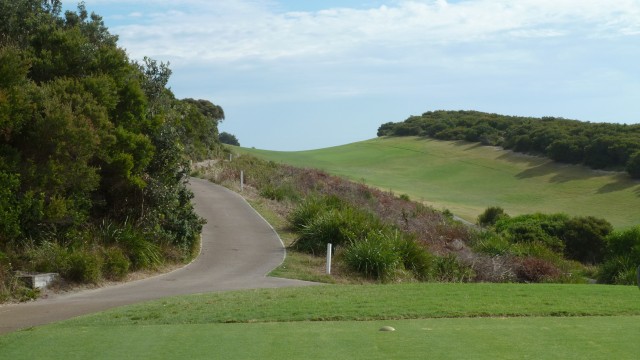
Hole 15 – 364 meter par 4
The fifteenth is ranked the hardest hole on the course. At 364 meters, this par 4 has a slight dogleg right. From the tee there is a tight uphill shot to a narrow fairway, which is at an acute angle to the tee box. This fairway also slopes in towards the middle from both sides, with tea tree surrounding both sides of the fairway. The tee shot needs to reach the top of the hill to avoid a blind second to the green, which would need to carry the hill and cut across a corner of the tea tree.

Approach to 15th green
It is almost impossible to have the second shot from a perfect lie. All sections of the fairway have slopes of some sort. There are three bunkers surrounding this fairly flat green. There are gentle slopes around the green but overall if you reach the green in two, you are almost guaranteed a par.

17th – 130 meter par 3
Hole 17 is a short par 3, measuring 130 meters. Wind exposure, makes any tee shot difficult to land on the narrow green. A carry over scrub, ensures anything short will be a difficult shot to the green, but steep inclines exist to the left and right, which are even more difficult.

My recovery shot from 16th fairway to the 17th green
I had managed to almost put my tee shot on the 16th fairway after pushing the shot. The shot back up the hill is quite steep, but luckily I almost sank the shot. There is a great view from the green of the clubhouse and other holes on the course.

Hole 18 – 489 meter par 5
The last hole is a 489 meter par 5. From the tee there is an expansive fairway to land your shot safely. Three bunkers are in play for the long hitter, two left and one right. The face to these bunkers will guarantee the second shot will not reach the green, so avoid at all costs. Waste area also exists on the left side of the fairway.

The 18th Green
The second shot from the fairway presents a challenge. For extremely long hitters there is the ability to reach the green in two, with safety to the left of the green, a large hill will funnel the ball towards the putting surface. Most people will be faced with a choice of where to lay up though. Leading into the green are four bunkers on the right, then another two on the left a little further along. Laying up short of these will leave an easy wedge shot to the undulating green, which is long and narrow. Many small mounds surround the green to make any chip shot interesting. Playing from the left of the green will be difficult with the green sloping from left to right.
I found the course to be in fantastic condition the day I played. The tee boxes were in great shape, with rotating ensuring not to many divots, they were also reasonably flat. The fairways were firm and well manicured and allowed a bit of run for the ball. The cuts of rough around the course was consistent, although best avoided, as it was difficult to play out of. The greens I found to be the biggest surprise, as they were quite soft, although they still ran quite quickly. Most had some tricky undulations and pin positions certainly helped to ensure they were in play.
Bunkering, which was a significant part of MacKenzies contribution to the golf course along with the routing, were typical of those found in the United Kingdom. Quite deep pot bunkers with steep faces to overcome, made any shot difficult if you were unlucky enough to find them. The only issue was that the sand was quite compacted (a complaint overheard from members of the course). One aspect which makes this course quite tough, is the lack of hazards. Most areas are unmarked, so if it looks like the ball disappears into the tea tree you better play a provisional, as it will deemed to be a lost ball. I was told on average two balls were lost a round. I guess I am above average as I managed five.
I must admit that I look forward to returning to play again one day. As I was told on the day play was easy due to the lack of wind. Although it was extremely humid and hot on the day we played so that made up for the lack of wind, in my mind.

View of the clubhouse from 11th tee
Here are the ways available to play NSW GC. Due to the land being government owned, there is a limited number of tee times made available to the public:
a. Book one of the tee times available to the public (weekday tee times)
b. Be invited by a member
c. Keep an eye on other websites for any open days


Comments
Since first playing NSW Golf Club, I have returned twice. Between my first and last visit there was some work carried out by Greg Norman. This included removal of excess vegetation to assist in speed up of play, addition of greenside bunker to the 4th hole and total replacement of the green surfaces with MacKenzie grass. This made significant visual improvements but also consistent surfaces on all greens. One day I will return to see how the putting surfaces have settled. The last time I played they were around 6 months old and still bedding in.